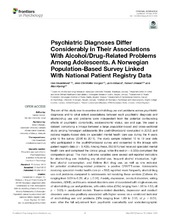| dc.description.abstract | The aim of this study was to examine alcohol/drug use and problems across psychiatric diagnoses and to what extent associations between each psychiatric diagnosis and alcohol/drug use and problems were independent from the potential confounding effects of psychiatric comorbidity, socioeconomic status, sex and age. We used a dataset comprising a linkage between a large population-based and cross-sectional study among Norwegian adolescents (the youth@hordaland conducted in 2012) and national registry-based data on specialist mental health care use during the 4 years prior to the survey (2008 to 2011). The study sample included 16 to 19 year olds who participated in the youth@hordaland survey and consented to the linkage with patient registry data (n = 9,408). Among these, 853 (9%) had received specialist mental health care and comprised the clinical group, while the rest (n = 8,555) comprised the comparison group. The main outcome variables were several self-reported indicators for alcohol/drug use, including any alcohol use, frequent alcohol intoxication, high-level alcohol consumption, and lifetime illicit drug use, as well as one indicator for potential alcohol/drug-related problems: a positive CRAFFT-score. Adolescents receiving specialist mental health care (n = 853) reported more frequently alcohol/drug use and problems compared to adolescents not receiving these services (Cohens d’s ranging from 0.09 to 0.29, all p ≤ 0.01). Anxiety, depression, conduct disorders, eating disorders, ADHD, and trauma-related disorders were all associated with single measures of alcohol/drug use and problems, with odds ratios (ORs) ranging from 1.58 to 4.63, all p < 0.05) in unadjusted models. Trauma-related disorders, depression and conduct disorders were also positively associated with higher scores on a combined indicator of alcohol/drug use and problems (ORs ranging from 1.89 to 3.15, all p < 0.01), even after the full adjustment from psychiatric comorbidity and sociodemographic variables (adjusted odds ratios ranging from 1.61 to 2.79, p < 0.05). These results suggest that alcohol/drug use and problems were slightly more common among adolescents who received specialist mental health care during the past 4 years compared with the general adolescent population, and adolescents with trauma-related disorders, depression and conduct disorders were high-risk groups for alcohol/drug use and problems. | en_US |

